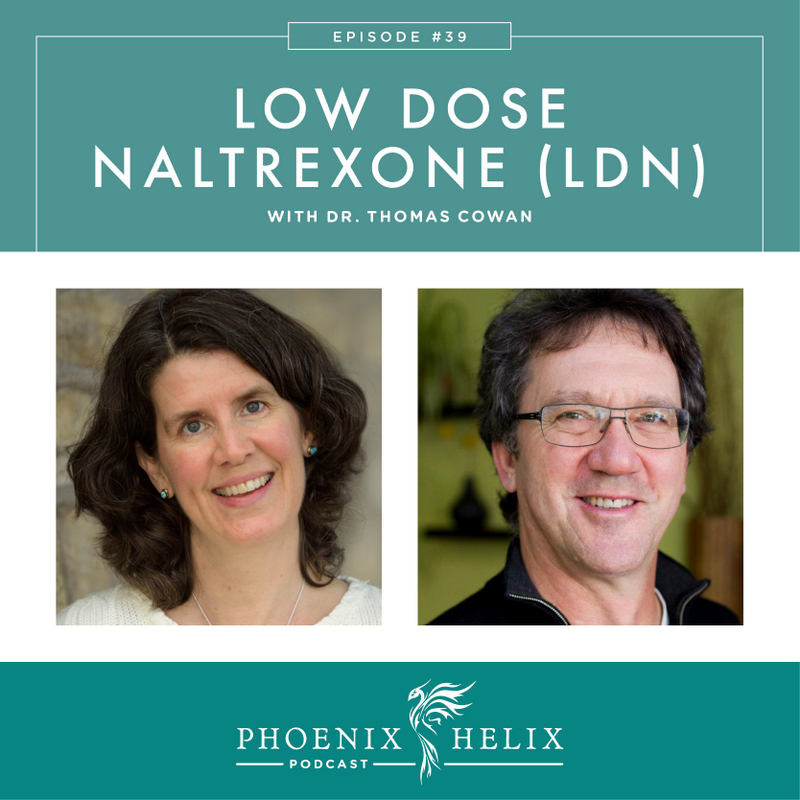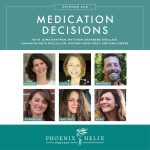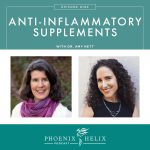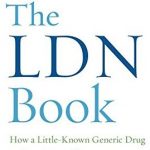What Is Low Dose Naltrexone?
Naltrexone is a medication that blocks opiate receptors in the brain. It is most commonly used at a high dose (50 mg) to treat heroine addiction. In the 1980’s and 90’s, researchers discovered that using it at a very low dose (1-4.5 mg) helped people with autoimmune disease without the high cost or side effects of conventional autoimmune medication. Today, we’re going to learn more about this nontraditional autoimmune medication – how it works and how to find a doctor who prescribes it. Our guest is Dr. Thomas Cowan, a medical doctor in San Francisco who has used Low Dose Naltrexone (LDN) for many years as part of his autoimmune patient treatment plan.
Listen to the Show
- Subscribe to my podcast through your favorite podcast app: iTunes, Stitcher, Google, TuneIn, Spotify, Amazon, etc.
- You can also listen to the episode right here through the player below, and if you subscribe to my newsletter you’ll get notified of future episodes.
Podcast: Play in new window | Download
Show Notes
- Intro (0:00)
- Thank You to our Podcast Sponsor – Paleo on the Go (2:02)
- A frozen meal delivery service, they have a large menu of items for the paleo autoimmune protocol (AIP).
- Use the code PHOENIX for 10% off your first order.
- Meet Dr. Thomas Cowan (2:41)
- Dr. Cowan is a medical doctor in San Francisco who uses LDN with his patients with autoimmune disease.
- He is also the author of 2 books: The Fourfold Path to Healing and The Nourishing Traditions Book of Baby and Childcare.
- He went to medical school at Michigan State University but always knew he wanted to practice medicine in a non-conventional way. He started practicing Anthroposophical Medicine in the 80’s and 90’s. Now, he doesn’t define his practice under any specific philosophy other than working with the body’s natural wisdom in helping his patients heal.
- How LDN Affects Autoimmune Disease (11:08)
- Food antigens like gluten and casein, when absorbed into our bloodstream through leaky gut, become toxic opiates that interfere with our immune response.
- Low Dose Naltrexone replaces these toxic opiates with healthy ones instead, helping the immune system rebalance. It does this by temporarily blocking opiate receptors in the body for a few hours while you’re sleeping. During that time, the body tries to overcome the block by releasing extra opiates called endorphins.
- Endorphins run the immune system – our immune cells, and the cells of our gut and brain, have a high number of endorphin receptors. People with autoimmune disease often have a combination of low endorphins and high toxic opiates.
- Why LDN Works for Some People and Not for Others (16:51)
- Results with LDN vary – everything from having no effect at all, to mild improvements, to achieving autoimmune disease remission. Dr. Cowan has seen this range in his practice as well. It’s worth trying because if it does work, it’s an inexpensive medication ($20-60/month) with minimal side effects.
- LDN has been mentioned on two prior podcasts as being very effective for two of my guests: Emily who has rheumatoid arthritis talked about her LDN success on Episode 33 , and Chelsey who has Crohn’s disease talked about her success on Episode 35. You can also see other video testimonials online through the LDN Research Trust.
- One reason LDN may not work is if someone hasn’t changed their diet and continues to eat foods likely to turn into toxic opiates in their body (like gluten in wheat and casein in dairy).
- In other cases, some people’s bodies might not be able to produce the extra endorphins needed.
- Finding the Right LDN Dosage (20:20)
- The original recommended dose was 4.5 mg before bed. Now, they know that dosage needs vary between individuals from 1-4.5 mg.
- Dr. Cowan starts his patients with 1 or 1.5 mg for 2 weeks and then asks them to report back. If there is benefit at that level, he doesn’t raise it further. If there’s no benefit, he will double the dose to 2-3 mg. They report back in 2 weeks again. If it’s beneficial at that level, he’ll leave it there. If there’s no effect, he’ll raise it to the maximum 4.5 mg. Note: When there’s a negative effect at any level, he doesn’t have his patients continue for two weeks, but rather call him so he can lower the dose by .5 mg immediately.
- With LDN, more is not more effective. It’s about finding the lowest beneficial dose, and effectiveness disappears at higher levels.
- Another option with people who have side effects at the lowest dose is to take it every other day.
- Those people who benefit from LDN will usually receive benefit as long as they continue to take it. It’s not a temporary medication, although you can take breaks from it to test if you still need it.
- It can sometimes take 2-3 months before noticing a benefit, although it’s also possible to feel a dramatic effect the very next day.
- Potential Side Effects
- Insomnia and bad dreams – although this is usually caused by going on too high a dose too quickly.
- Compounding Pharmacies (27:01)
- This is an off-label use of Naltrexone medication, which means there are no tablets available at this low a dose. Instead, you need to have the medicine made through a compounding pharmacy.
- LDN needs to be combined with fillers. You want to make sure the fillers are fast-releasing and allergen-free.
- List of compounding pharmacies experienced with making LDN.
- If you tried LDN and it didn’t work for you, you can try again from a different pharmacy. Sometimes that makes a difference.
- Finding an LDN-Prescribing Doctor (35:08)
- You can ask your current doctor for a prescription, but many conventional doctors don’t believe in LDN and won’t prescribe it. If that’s the case for you, here is a list of LDN-Prescribing doctors.
- However, Dr. Cowan recommends you find a physician who uses LDN as part of his autoimmune treatment plan and guides you in other ways as well, because LDN (independent of addressing diet, lifestyle and other factors) isn’t as effective. I have a list of Paleo Functional Practitioner Directories.
- Research Into LDN and Autoimmune Disease (38:41)
- Update: The LDN Book was published in 2016 which summarizes all of the research. And a second volume is due to published in 2020.
- The LDN Research Trust is funding clinical trials.
- Clinicaltrials.gov lists both completed trials and ones that are recruiting participants.
- Pubmed contains published research results.
- New research: With non-autoimmune hypothryoidism, there is a developing theory of thyroid hormone resistance – where blood levels are normal yet hypothryoid symptoms are being exhibited. LDN can help with that resistance. There is also research into using LDN for anxiety and depression. All of this is summarized in The LDN Book.
- Helping Patients Make Medication Decisions (43:14)
- As an MD, Dr. Cowan uses a combination of alternative and conventional medicine as needed for his patients with autoimmune disease. While the goal is to avoid or eliminate immunosuppressant medication and the symptoms they are suppressing, that can take time. It’s important to do that under the guidance of a doctor who specializes in reversing autoimmune disease. Trying to go off medication cold-turkey leads to autoimmune flares.
- Outro (47:11)
- Update 2023: Dr. Cowan has retired from his clinical practice.
- Eileen (your podcast host) is the author of multiple books, written to help people thrive with autoimmune disease. Learn more on the Books Page.
- If you like this podcast, follow or subscribe through your favorite podcast app. You can also subscribe to Eileen’s biweekly newsletter.
- Check out the entire archive of podcast episodes.
You May Also Be Interested In
Spreading the Word
If you like the podcast, please leave a positive review in iTunes. It would mean the world to me, and also helps others find the podcast. Here are some quick instructions using your iPhone:
- If you are already subscribed to my podcast: (1) Click the purple podcast icon. (2) At the bottom of the screen, click Library. (3) At the top of the screen, click Shows. (4) Click the Phoenix Helix podcast image. (5) Scroll down the page, and you’ll see Ratings and Reviews. Scroll down a little bit more and click on Write a Review. This will bring up the review screen. Tap 5 stars (if you love the podcast), and then click in the title box, and it will bring up the keyboard. Enter a title and short review. (6) Click Send in the upper right corner. (7) Thank you! Positive reviews give the podcast a higher search ranking in iTunes, helping people find it and letting them know it’s a quality podcast and worth their time to listen.
- If you haven’t subscribed to my podcast: (1) Click the purple podcast icon. (2) In the lower right corner, click the magnifying class. (3) Type Phoenix Helix in the search box. (4) Click the podcast cover in the Show list. (5) If you’d like to subscribe, click the + sign at the top of the screen. (6) To write a review, scroll down the page, and you’ll see Ratings and Reviews. Scroll down a little bit more and click on Write a Review. This will bring up the review screen. Tap 5 stars (if you love the podcast), and then click in the title box, and it will bring up the keyboard. Enter a title and short review. (7) Click Send in the upper right corner. (8) Thank you! Positive reviews give the podcast a higher search ranking in iTunes, helping people find it and letting them know it’s a quality podcast and worth their time to listen.









Ok, after listening to this podcast I started taking LDN. I have been suffering for one year with pain in my joints, muscle spasms, vertigo, brain fog, muscle twitching, swelling of the feet, red skin rashes, light sensitivity, weakness (couldn’t raise my arms above my shoulders or hold a phone for more than a minute), couldn’t sleep more than 15 minutes at a time or parts of my body would fall asleep and ache in pain. The doctors have had no luck with diagnosis up to this point. Frustrated, I asked my doctor if she would prescribe LDN. She told me ok, but didn’t think it would help. She was upset because she wanted me to take methotrexate and I refused. I changed my diet and I I have been on LDN for 3 weeks now and I feel like I have my life back!!!!!!!!! Praise God!!!!! Thank you!!!!! I have only 10% Or less of the symptoms I had before. And I feel like I am getting stronger. My inflammation is leaving my body. I hope this post helps others to give it a try!!!! Let me know if I can help you in any way. Matt Ponce
Matt, that’s wonderful! Thanks so much for sharing your experience.
Can anyone tell me what type of fillers may be in the liquid LDN? I started on it for Hashimoto’s and Chronic Fatigue, however, I have extreme sensitivity to oxalates that interfere with neurotransmitters and cause my compulsions to be much worse. I’m not sure if its the fillers or the LDN itself that causing this.
Hi Vina. The pharmacy where you got the LDN should be able to answer that question.
Does caffeine competes with LDN?
Rita, No – I don’t believe it does.
I am a nurse and I am on LDN from November feeling great .I refused to take high dose of steroids and methotrexate for long term as the only management for EF.effects? From being crippled to being back on my 2 feet and back to my active life.very happy with my decision knowledge is power and listen to your body.
Thanks for sharing, Iuliana. I’m so glad LDN is working for you!
So glad you posted this! I have been on LDN for 1 week now. This was such a good program. I am on 1.5 mg for 30 days and will double that after the 30 days. Thank you again Eileen!
Perfect timing, Tracy! May you find the dose that’s perfect for you.
Thanks for this podcast, it was great to hear about this topic. I have hashimoto’s and have been on an AIP diet. I had adrenal antibodies show up for a short while before I started AIP but they are gone now. I wish you had asked the Dr Cowan if LDN was effective for adrenal autoimmunity or if it is something that would exacerbate the condition. From previous reading about it I gathered that the endorphins were produced in the adrenal glands (I could be wrong about this) and LDN for them would be like throwing gas on the fire if already have autoimmunity going on. Is this true? Thanks
RAnne, since Dr. Cowan is accepting new patients, you might want to consult with him directly on this issue.
I have been on the AIP diet for a month and have had no RA flare ups with only one or two episodes of slight inflammation. My doctor suggested I start taking LDN along with my Actemra infusions and Arava. Do you recommend I take LDN now that I am on AIP with no symptoms? How would I know if I would be responding to LDN or AIP diet?
Hi Liz. I can’t give medical advice, so I would ask your doctor that question. Ideally, you don’t want to make medication changes while doing the AIP, but your doctor might have a good reason for wanting you to take LDN sooner rather than later. Ask your doctor’s opinion about whether it would be OK to delay LDN a few months until you’re more clear about your AIP results.
Thank you for this podcast. It was full of great information. Did I hear you say caffeine was a toxic opiate? I have changed my diet but I didn’t realize this.
Hi Diane. Dr. Cowan said casein, not caffeine. Casein is the protein in dairy, and many people have a similar intolerance to it that they have to gluten.
Hi Eileen, I’m in Italy, and I just want to let your European readers know that I’ve done a course of LDN, and my doctor is listed in the LDN Prescribing Doctors Link above. I don’t have an AI disease, just an ‘issue’ with active antibodies and chronic inflammation. I don’t know if the LDN was effective for me – I was taking so many other things at the same time: Vitamins, thyroid supplements, hormones. What I can say is that my situation has improved greatly over the last three years – I’m now getting out of bed in the morning like a normal person! – and I put it all down to the Paleo Diet and Lifestyle, and our Paleo Doctor who has been great. Best wishes, A
Angie, thank you for sharing your experience. May you continue to feel better & better!
Thank you for posting this podcast. I’ve shared the link with a group of parents who have children with intractable pain. Often times LDN helps. Because it’s off label not all pediatricians know about it and this will give them more information to speak to their Dr about it. Thank you.
Thanks for sharing the resource, Susan! It’s heartbreaking to think of children in pain.
LDN has done wonders for me in my LYME and Bartonella treatment. I’ve had no issues other then to switch my dose to early morning because it wakes me right up.
That’s wonderful, Lisa. Thanks for sharing your experience!
Great and timely podcast for me. I have Hashimoto’s and have been on LDN for 6 months. My endo, who is a functional medicine endo (lucky me) asks if I think it works. I still have symptoms so my thought is no. This was great advice to take for tomorrow about adjusting the dose. I have never completely understood how it works but now have such a better idea.
After a year I am still unable to decrease my antibodies through diet, lifestyle changes, etc so I would appreciate a point in any direction you may know from prior guests. I just started listening a month ago so am still working through all the old podcasts.
Much appreciated,
Mike
Yes, finding the right dose with LDN is so important. And it also helps to know there are a range of responses – for some people it’s a subtle improvement, and for others it’s a dramatic one. The dose doesn’t change that – but it can make the difference in whether it works at all. As for the old podcasts, I recommend listening to my interview with Andrea Nakayama, if you haven’t already. The topic was Hashimoto’s. Wishing you wellness in every way.
Thanks for this very explanatory interview on Naltrexone. I was given this a few months ago at a low dose of 1 mg. once day. But I became very anxious and was unable to sleep. My integrative medicine doctor said it had something to do with me still relying on Tramadol for pain for the RA, and said he’d wait until trying it again. The theory is that his treatment with supplements, herbs etc. is improving my symptoms and pain so that I will rely less and less on Tramadol – which is true; I take less Tramadol than I have, on most days. And when I have less Tramadol in my system, then we can try Naltrexone again. My question is why Naltrexone and Tramadol are interacting, if they are, or if perhaps my dose should be lower than 1 mg. I realize this may be a difficult question to answer. But thanks in advance, just in case. And thanks so much for all you do Eileen.
Susana, we can’t provide individual medical advice, but I can tell you that both Tramadol and Naltrexone interact with opiate receptors in the brain, so it’s logical that would make both medications less effective as they compete for those receptors. Here’s a FAQ information page on Tramadol.
Thanks much. Makes sense.